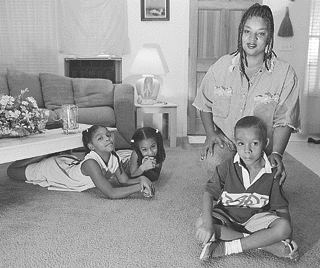There's No Place Like Home
Fri., Aug. 21, 1998
|
|
Lisa Robinson's three-bedroom duplex on East Eighth Street may not have central air conditioning, but that's a minor privation compared to the homelessness and public housing she and her two children had known before. Amply furnished with a sectional sofa, dining room table, and drapes, the duplex is the Robinsons' first home in several years that has lent enough permanence and security for Robinson to invest in store-bought furniture. It came to them through a rare stroke of good fortune - when Robinson was selected by the Guadalupe Neighborhood Development Corporation (GNDC) for a vacancy in one of its low-priced rental properties. When the call came, it was a turning point in the Robinsons' lives. "It was like, `I'm excited, I'm flying!' " Lisa Robinson recalls.
The Robinson family formerly lived at the Mason Manor public housing complex, and would probably still be there if not for the GNDC duplex. Robinson had been trying to move her family out of the complex, away from the junkies and drug-dealers who loitered on her front stoop, but she had been constantly foiled by high rents that her $13,000-a-year job at Huston-Tillotson College couldn't support. Many landlords in Austin, even those who operate "affordable" rental units, charge at least $600 for three-bedroom apartments, and require a minimum monthly income three times the amount of the rent.
"I don't think I could make it, living in a $600-700 apartment," Robinson says. "But that's what I was running into - I didn't make enough money for anybody to give me an apartment; they wouldn't even rent to me." So it's not surprising that Robinson considered it well-nigh miraculous to land a tidy duplex with a porch and a yard for just over $300 per month through the GNDC.
Unfortunately, the Robinsons' happy story is not a common one. Nonprofit, neighborhood developers such as the GNDC and others - Blackland, Blackshear, and Anderson - provide only a handful of cheap rental units, and represent only a fraction of the development that goes under the rubric of "affordable housing" in Austin. The majority is provided through tax-exempt bonds or federal tax credits - developer incentives which, while capable of leveraging the millions of dollars needed to build affordable apartments in greater numbers, don't provide rents that single-earner households like the Robinsons can afford. Even now that Robinson has a full-time, higher-paying job as a secretary, her $19,000-a-year salary would not meet the minimum income requirements on a $600 apartment. Had the GNDC not been able to help them, the Robinsons would be one of the thousands of households in the city facing a doozy of a step upward out of public housing, or shelling out over half their income for rent and going without health insurance, reliable transportation, and other securities.
"People don't usually tell us they've found something better," says GNDC property manager John Ancira. "We get a lot of people who've been paying $600-700 for a one-bedroom. Shh... how can you live like that?"
Some might ask how the GNDC itself survives, charging rents which are actually below what IRS guidelines for tax-exempt rental properties allow. But director Mark Rogers, who has been central to the nonprofit since its inception in the early 1980s, says that GNDC's properties are paying for themselves, and that any income residents save on rent enhances their savings and contributes to the neighborhood's prosperity.
That's certainly been true for the Robinson family, now living fully insured with two cars parked in the driveway. "Things are getting a lot easier; I'm just thrilled `cause I've been struggling for so long," Robinson says. "You got a lot of people out there who think they're too good for the housing projects ... They'd love to have this, but not public housing." City officials, too, would love for public housing recipients to have what Robinson has, what with 2,000 people in the Austin area waiting for public housing vacancies or Section 8 vouchers, even as Congress screws down the tap on HUD subsidies. City housing officials say they hope to increase the Community Housing Development Organizations' share of the federal housing pie to 30% in the near future, but that will still be a tiny dollar amount compared to the government assistance that goes into building higher-priced rental properties through tax credit and bond incentives. For now, small developers like the GNDC can help only a few people, while the rest sit on waiting lists at subsidized housing complexes or knuckle down under taxing rents. Thus far, most affordable housing initiatives aren't lowering the rope low enough for people at the bottom end of the wage scale, and their climb upward is more like scaling a cliff than stepping up a "stairway to self-sufficiency." - K.F.
Got something to say on the subject? Send a letter to the editor.







